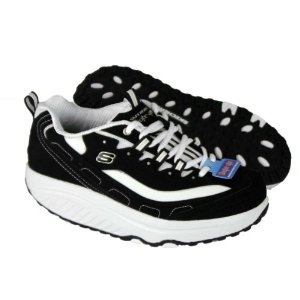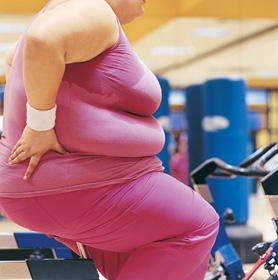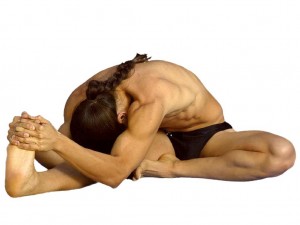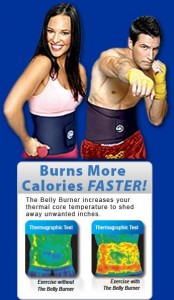
Recent Blog Posts
April 18, 2011
High Heels Bad for the Joints?
It’s well-known that if you place a muscle in a chronically shortened position, the muscle will adapt by shortening (i.e. losing sarcomeres in series) over time. This is one of the theories as to the genesis of lower back pain (LBP), where long periods of sitting cause the hip flexors to tighten, pulling the pelvis forward and thereby increasing strain on the lumbar region. While it should be noted that some researcher dispute whether this actually does lead to LBP, nevertheless the change in muscular structure does result in imbalances between core muscles, and that’s never a good thing.
With this in mind, a recent study caught my eye. Researchers from Manchester, UK (1) investigated whether wearing high heels cause the gastrocnemius (one of the calf muscles) and the Achilles tendon to shorten, thereby compromising lower body function. The study included 20 women, 11 of whom wore high heels on a regular basis (the other 9 served as a control group). As might be expected, results showed that the gastrocnemius muscles of the women who wore high heels were in fact shortened, and their Achilles tendons displayed increased stiffness. The researchers speculated that the combination of factors might reduce the active range of motion in the ankles of those who wear high heels, possibly explaining why these women experience discomfort when walking in flat shoes. Interestingly, however, there was no loss of force production at the ankle joint, as apparently the increased tendon stiffness compensated for the reduced force capacity of the muscle.
The take home message here is that chronically placing a muscle in a shortened position will have negative effects on that muscle. And since every muscle is counterbalanced by an antagonist muscle, this ultimately leads to imbalances in your body that may have detrimental effects. Bottom line: try to limit the amount of time you spend in heels; they may look good at the time, but their long-term effects might not be worth the short-term satisfaction.
Stay Fit!
Brad
1) Csapo R, Maganaris CN, Seynnes OR, Narici MV. On muscle, tendon and high heels. J Exp Biol. 2010 Aug 1;213(Pt 15):2582-8.
December 2, 2010
Functional Fitness Article
My friend and colleague, Mike Bates (who is owner/director of the terrific training facility, Refine Fitness), did a nice job summarizing some of my findings on functional training in a recent article appearing in the Windsor Star newspaper. Below is a link to the article. Happy reading!
Find out what works best for you
Stay Fit!
Brad
August 24, 2010
Never Too Old to Exercise!
Here is an inspirational video of a 72 year-old woman, Ernestine Shepherd, who is in amazing shape–not just for a senior citizen, but for someone of any age! Ernestine recently won the Guinness World Record Award for the oldest female bodybuilding champion. She is a true fitness inspiration and reinforces just how beneficial exercise is for everyone, no matter their age.
embedded by Embedded Video
August 1, 2010
ACE Study on Toning Shoes
“Toning shoes” are the new big thing in the sneaker business. Sketchers, the manufacturer of Shape-ups, call them “…a great way to exercise while you go about your busy day!” and profess that “…walking in Shape-ups can help burn more calories, tone muscles and more.” Sounds like a great concept, right? Reebok (Easy Tone), New Balance (TrueBalance) , and other sneaker companies have jumped into the market with similar products that claim to help you get into shape without ever setting foot in a gym.

I was recently provided with a pair of toning sneakers to test out. On the surface, the theory behind toning shoes seems reasonable. The shoes are designed with a curved sole. This creates somewhat of an unstable environment, which should theoretically require users to increase muscle activation to facilitate balance. Question is, do these sneakers really live up to the hype? Sadly, the answer is not much, if at all.
While toning shoes do provide a measure of instability during walking, the overall effect is very slight–certainly not enough to have a meaningful impact on muscle development, posture, balance, and other fitness parameters. Other than those who are rehabbing a lower ankle sprain or are very unfit, I can’t imagine they would provide any additional fitness benefits at all. A recent study conducted by the American Council on Exercise (ACE) backs up this view. The study compared the exercise responses and muscle activation between walking in traditional athletic shoes versus toning shoes. The results? Neither exercise response (as measured by ratings of perceived exertion, oxygen consumption, and caloric expenditure) nor muscle activation (as measured by EMG) showed significant differences between the two groups.
Moreover, given their unusual design, it is possible that toning shoes may alter normal gait patterns. This could potentially increase the possibility of injury to soft tissue structures, particularly in those who have existing joint problems in their lower extremities. Thus, someone rehabbing from a lower ankle sprain (seemingly a target consumer for the product), should think twice before purchasing a pair.
That said, injury associated with wearing toning shoes should be of little concern to otherwise healthy individuals. I actually found the shoes to be quite comfortable once you get used to them. The additional cushioning produces an airy feel, and absorbs ground reaction forces nicely. Thus, while they might not provide any additional fitness benefits, they can be considered a viable alternative to traditional sneakers if you’re simply looking for walking comfort.
Bottom line: Don’t expect to get fit simply by walking around in a pair of toning shoes. When something sounds to be too good to be true, it usually is. That’s the case here. If you want to shape up, you’re going to have to work out. There are no shortcuts.
Stay Fit!
Brad
July 25, 2010
Wrap Up of NSCA National Conference
As mentioned in a previous post, I lectured this past weekend at the 2010 NSCA national conference held in Orlando, Florida. While there, I was fortunate to be able to attend several presentations from some of the leading experts in exercise and sports nutrition. Here is a brief rundown of some of the highlights:
- Mike Waller and Tim Piper presented on “Teaching and Understanding the Snatch and Squatting Techniques.” They did a solid job covering proper form in performing these exercises. With respect to the snatch, they proposed various progressions for learning the exercise. These progressions involved breaking down the movement into components (i.e. overhead squat, pull from floor, high pull, etc), which ultimately leads to performing the movement as a whole. This is a popular technique in motor learning and works very well with complex moves such as the snatch. Overall a very informative session.
- Dr. Jeff Stout presented on ” The Performance Enhancing Power of Milk.” This was an interesting lecture that made the point that milk is actually an excellent post-workout drink. Dr. Stout is one of the foremost researchers in nutrition, and he did a good job covering the science of the nutrients contained in milk and their benefits for those who exercise. An important point made was that the two fractions of protein contained in milk (whey and casein) have an additive effect with respect to increasing protein synthesis post-workout. It is often believed that whey is the superior protein to consume after a workout since it is “fast acting” and thus gets to the muscles more quickly. However, recent research indicates that a combination of whey and casein actually provides even greater benefits, as their actions are synergistic with respect to increasing protein synthetic rate.
- Dr. Andy Fry presented on “Sports Nutrition Needs and Supplements for Overtraining and Recovery. Dr. Fry took a refreshingly scientific approach to the topic, and discussed the drawbacks when looking at studies on the topic. My favorite part of the lecture: the four things to consider when evaluating a research study. 1) Could results be taken another way? 2) What methodological flaws are evident? 3) How generalizable are the results? 4) How do these study results fit with what we already know? Bottom line: don’t just look at the results of a study and take them at face value; instead, look deeper into the specifics about how the study was conducted.
- Dr. Morey Kolber presented on “Shoulder Disorders Attributed to Weight-Training: Preventative Implications.” This was an extremely well-researched presentation that looked at the incidence of shoulder injuries in those who lift weights regularly. One of the most salient points made was that a majority of lifters have excessive internal rotation, which places the rotator cuff under significance stress when lifting overhead (i.e. shoulder presses, etc). Dr. Kolber presented various strengthening exercises for the external rotators (i.e. infraspinatus and teres minor), as well as stretching exercises for the internal rotators to improve shoulder joint range of motion. Sound advice that should be embraced by those in the fitness field.
There were many other excellent speakers, but given that many of the sessions ran simultaneously as well as other time commitments that I had at the conference, I was unable to attend all the presentations that I would have liked. Next year’s conference will be at the Paris Hotel in Las Vegas and promises to be another terrific event. Hope to see you there…
Stay Fit!
Brad
July 7, 2010
The Biggest Loser
A reader sent me this video, where a former contestant of NBS’s The Biggest Loser revealed some disturbing truths about the show.
embedded by Embedded Video
Apparently this comes as a surprise to many of the show’s loyal viewers. If so, it shouldn’t. Reality check: shows like The Biggest Loser are nothing more than fitness theater. It’s not real life. Sure, contestants lose a ton of weight. They are placed in a controlled environment, follow what amounts to a starvation diet, and are subjected to hours upon hours of exercise. Based on Newton’s First Law of Thermodynamics, expending more calories than you take in will result in weight loss. Can’t argue with physics.
But this is neither a realistic way for the rest of the world to to pursue weight loss, nor is it a good strategy for lasting weight management. What’s particularly disturbing is the pressure to which contestants are subjected in order to lose more weight than the other competitors. As claimed in the video, the extreme dehydration techniques employed are dangerous to say the least. Moreover, the trainers on the show display a complete lack of understanding about exercise physiology, and often have contestants perform acts that utilize poor form and are highly risky for their current fitness level (apparently a number of contestants have been hospitalized).
The bottom line is that weight loss should be approached systematically. A realistic goal is to lose about 1-2 pounds per week. Over the course of six months, this can equate to 50 pounds of fat loss! Best of all, this can be accomplished with a sensible nutritional regimen and a properly structured exercise program performed 3-4 days a week; something everyone can follow. Before you know it, you’ll be sporting a terrific body while those TV contestants have all gained back their previous weight.
Stay Fit!
Brad
May 10, 2010
Can You Be Fit and Fat?
Is it possible to be fit if you’re fat? A study by Weinstein et al. (2008) sheds some light on the issue. The study investigated the relationship between being overweight/obese (as measured by BMI) and indices of cardiovascular health in over 38,000 middle-aged and older women. Results showed that the overweight/obese subjects who were physically active significantly reduced their risk of coronary heart disease, with greater levels of physical activity associated with an greater reduction in risk. Sounds good, right? Not so fast…

Unfortunately, women who were overweight/obese showed an increase risk for coronary heart disease regardless of physical activity compared to lean women. These results held true even in those who engaged in high levels of exercise. What’s more, the study didn’t consider other health issues associated with obesity, such as cancer, metabolic disorders, and joint disease.
The bottom line is that just because you exercise doesn’t give you Carte Blanche to eat whatever you want. Exercise certainly will make you “fitter” if you’re fat, but the excess weight poses a health risk no matter how active you are. Regardless of activity levels, you still need to watch your waistline!
Stay Fit!
Brad
Weinstein AR, Sesso HD, Lee IM, Rexrode KM, Cook NR, Manson JE, Buring JE, Gaziano JM. The joint effects of physical activity and body mass index on coronary heart disease risk in women. Arch Intern Med. 2008 Apr 28;168(8):884-90
December 14, 2009
To Stretch or Not to Stretch
The Miami Herald ran an interesting article questioning the benefit of stretching before a workout. For the most part, the article makes some excellent points.

Contrary to popular belief, a large body of research shows that stretching prior to exercise has no effect on decreasing injury risk. Yes, improving flexibility can help in injury prevention depending on the activity. Tight muscles have been implicated as a potential cause of various injuries, and improving flexibility can help to reduce this possibility. However, it doesn’t matter when the stretching is done. The only concern is that you achieve adequate range of motion for the task you want to perform. As the Nike ad says, “Just do it!”
Most importantly, stretching is best performed after a good warm-up. This helps to reduce joint viscosity, ensuring that muscles and connective tissue are sufficiently prepped to endure passive and/or active lengthening. Some light aerobic activity performed for 5 or 10 minutes will accomplish this task well. Take home message: Don’t stretch a cold muscle.
Interestingly, there actually is some evidence showing that stretching before a workout can have a negative impact on exercise performance. This is most applicable to activities requiring high-force output, such as low rep weight training, sprinting, and jumping. I won’t bore you with the details on the how’s and why’s, but bottom line is that various indices of power have been shown to be reduced when a forceful activity is performed immediately following a stretching session.
However, caution needs to be used when applying much this research to general fitness-oriented workouts. First, most of the studies in question used excessive stretching protocols, in some cases spending upwards of 30 minutes stretching a single joint. This has limited applicability to the stretching protocols used by the majority of fitness enthusiasts.
Moreover, the studies are specific to high-power activities. This has questionable correlation to the moderate-to-high repetition resistance training performed by many gym goers, and virtually no correlation to sub-maximal cardiovascular exercise. More research is needed to achieve a better understanding of the subject. This is yet another instance that shows the importance of reading the actual research rather than simply listening to the media’s interpretation of science.
Stay Fit!
Brad
December 5, 2009
Fitness Fraud Alert: The Belly Burner
I was watching cable TV last night when a commercial came on the air for a product called the “Belly Burner.” I nearly dropped the cup of hot green tea I was drinking in my lap.
The ad for the Belly Burner shows several fit people securing a large neoprene belt around their waists with a promise that simply wearing the belt will help to develop “firmer, tighter, sexier abs.” Supposedly you don’t even have to exercise to see results, but the belt will “complement any exercise or physical activity: walking, biking, jogging, gym …”

The claim by the manufacturer is that the Belly Burner increases thermal core temperature, thus shedding the pounds and inches from your waist. To “prove” this claim, two thermal images with “heat vision photography” of a midsection are provided — one with with the Belly Burner, the other without it. Wouldn’t you know it, the photo using the Belly Burner shows all sorts of bright orange and yellow colors (supposedly indicative of greater heat) while the other photo is mostly a dull green and blue. Wow, some proof. Of course, as with all of these overhyped infomercials, assorted free gifts are offered including a DVD and calorie counter. Hopefully you’re not running to phone with your credit card just yet…
Let’s get down to the facts. Despite the claims, no peer-reviewed research supporting the belt’s validity is provided in the ad. None!. Based on current research, there is zero evidence to believe that the Belly Burner will have any affect on reducing your waistline. Rather, all evidence shows that you can’t increase core temperature by wearing a snug belt. At best, you might sweat a little more, which causes the temporary loss of body water — a process that is quickly reversed once you rehydrate.
Apparently the Belly Burner was invented by a “celebrity trainer” named Bobby Waldron. The ad says it used to be only available to his personal clients but now it is available to the public. Whoopee! A quick Internet search for Bobby Waldron reveals he is a model, actor, stunt man, and yes, a personal trainer. I’m not sure what order his priorities lie, but if the Belly Burner is his big contribution to the field of exercise, then he should stick with his other interests.
Unfortunately, the fitness industry is rife with hucksters that look to appeal to the naivety of the consumer with promises of an easy way to a great body. As long as there is money to be made, some entrepreneur is bound to try to capitalize for a quick buck. Don’t be scammed. When something sounds too good to be true, it usually is. By all accounts, that’s the case with the Belly Burner. Save your hard-earned money and train hard. That’s the only way you’ll get fab abs.
Stay Fit!
Brad
June 9, 2009
Exercise Video Demonstrations
I’ve posted several exercise demonstration videos on Youtube. These videos are from the DVD included in my book, Sculpting Her Body Perfect.
You can view the videos at the following link: Exercise Video Demonstrations. Feel free to rate the videos if you like them! Exercises include the correct performance of the sissy squat, walking lunge, seated row, and incline press. I’ll be adding more in the future. Enjoy 🙂
Stay Fit!
Brad







 Entries (RSS)
Entries (RSS)



